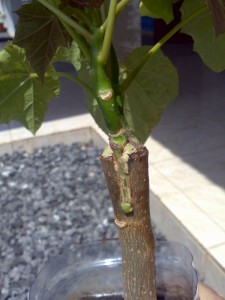There is not a lot of information out there in the public domain about Jatropha grafting. But as with many plantation grown tree species grafting can potentially play a major role in bringing JcL planting material up to commercial speed. There are several scenarios that could make grafting interesting:
- Less time to the first harvest of seeds. This feature would be especially interesting in the roll out of newly developed hybrids as well as in intermediary stages of breeding.
- Stronger, better adapted root stock for a cultivar with otherwise elite traits.
- Upgrading of an existent plantation or field with a newer, better variety.
Within our JcL 3.0 platform development we are looking into beneficial ways of bringing grafting to Jatropha. We are experimenting with various grafting methods as well as different possible type of root stock and study the long term behavior of grafted plants.
Just recently we did an interesting experiment using a Cassava (Manihot esculenta) plant as root stock and a fresh branch of our best local Jatropha as scion. Very surprisingly, after only 2 weeks we had a positive result:
A simple, but very effective veneer graft did the job. In another 4-6 weeks the connection will be complete and the ends can be cut off.
Further experiments need to be conducted for this combination, but it opens an extremely interesting route for JcL improvement work. Cassava has very unique survival properties and is the only crop plant in many semi arid tropical regions that develops well through the dry season. It is planted as cuttings and develops very strong tuber roots within 6-9 months which are the reason for growing this staple food in the first place.

